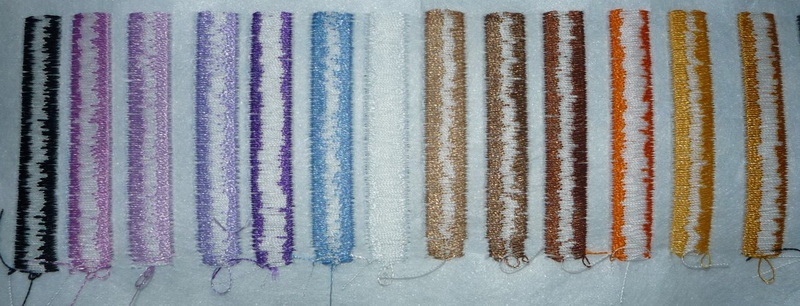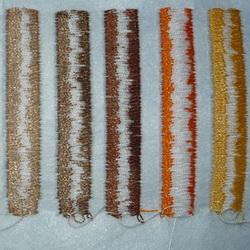Original text by: Marina Belova
Yesterday I once more learned from experience how much proper thread tension means — I embroidered a fluffy monster using acrylic yarn and got several 'birds nests' and plenty of thread breakage. I think that anyone would agree that the embroidery machine tension balance in important.
For example, my upper thread tension was too loose, which resulted in 'bird nesting' on the wrong side and massive thread breakage together with the ugly loops on the right side of the embroidery. In case the upper thread tension was too tight, the underthread might have shown on the right side of the fabric. Which would not make the embroidery look better.
The same with the bobbin thread. If the tension is too loose, the thread will appear on the right side of the fabric, too tight – the upper thread will be sucked underneath, causing all those loops on the right side. My lower thread tension was too tight, that's why there was so little of bobbin thread on the wrong side.
In any case, finding the middle ground would be the best.
What influences the thread tension during the embroidery? Everything. There are many issues that at first sight may seem irrelevant:
- Type of thread
- Thread thickness
- Embroidery machine speed
- Needle size
- Obstructions in the thread path.
Not once nor twice I've seen the recommendations to test the thread tension before every new embroidery, new fabric or new type of thread. Is it necessary to get a 100% result.
But how will one know whether the thread tension is correct if there are no special tools?
There are several kinds of test designs. You can find them on the internet or create your own.
It is believed that when the tension is correct, the upper thread takes 2/3 and the underthread — 1/3 of the width of the satin columns on the wrong side of the fabric. They should appear in such order: upper/lower/upper. This is what you take under control after all the tests are completed.
I test
This test design is an English letter "I" about 2,5 cm (1 inch) high and 3-4 mm wide. It is composed of single oriented stitches only. The design is embroidered with all the needles on a stabilized fabric or a dense cutaway stabilizer. After that you inspect the wrong side in order to see, what should be adjusted. According to results you make the adjustments and test again.
H test
This design is an English letter "H" about 2,5 cm (1 inch) high, with 6 mm wide vertical satin stitches and 5 mm wide horizontal ones. Stitches are oriented in 2 directions. The design is embroidered and the tension is adjusted according to the result.
Т test
This test design is an English letter "T" about 2,3 cm (1 inch), which is embroidered both directly and in the mirror image. Satin columns are about 5 mm wide, but there are plenty of angles. The design, too, is embroidered, and the tension is adjusted according to the results.
Flags test
On www.coldesi.com, where SWF embroidery machines are presented, I've found an interesting chevron-like test design. I suppose they didn't create it just for fun, so I recommend using it, too.
FOXY
This test design is an English word "FOXY", written in capital letters consisting of satin columns. They are about 2,0 cm (circa 1 inch) tall. This test design is good because the stitches are oriented in many directions.
Fill test
This design consists of several 25x25 mm (1x1 inch) squares with 45° and 135° stitches arranged in a chess-board fashion. Again we embroider and then adjust. You can adjust the upper thread tension well so as to prevent loops.
Madeira test
I found another interesting test design on the USA Madeira website. It consists of a standard fill and 3 satin columns of varying width. A potpourri, so to speak. But it is single-oriented.
The experts advise to check the thread tension no less that once in a month.
Here I've tried to embroider one of the test designs:

Now I'll go to adjust the thread tension in my embroidery machine.
And last, the Drop test (yo-yo test)
This method is used for checking if the bobbin thread is correctly adjusted. You won't need your machine for this one.
Take the bobbin case out of the machine.
Wind the thread on your finger and pull about 15-22 cm out of the case.
Then you shake your hand up and down slightly
The thread must be pulled out of the case a bit.
How much — on that subject I've heard different values from different experts. They start on 1 inch and end on 3 inches (or 2,5-7,5 cm). Like always, you should try and see for yourself.
You can learn how to conduct this test if you watch this video.
You can read my blog on how to detect if the thread tension was correctly adjusted and what to do about it.



There are no reviews to display.